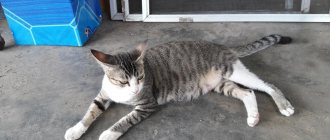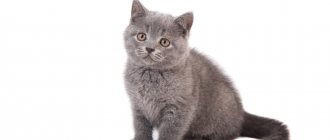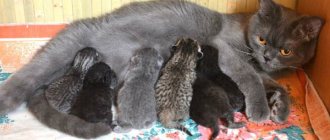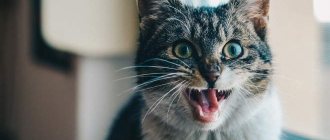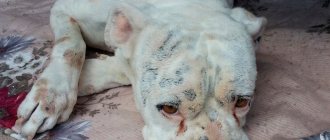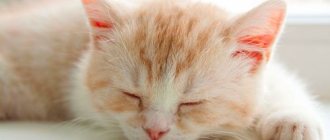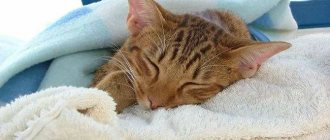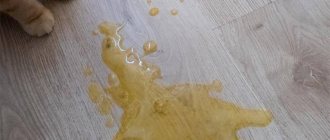Rapidly developing diarrhea and vomiting in a kitten indicates a serious illness, so you should immediately contact a veterinarian. If this is not possible here and now, then it is necessary to provide first aid, in particular to stop vomiting and diarrhea, and normalize water-salt metabolism.
However, you cannot self-medicate for a long time, since the cause of diarrhea and vomiting in a kitten can be infectious or invasive diseases.
Causes of abdominal enlargement in kittens
The most common reason for an enlarged belly in a kitten is feeding rough food. Remember that food intended for adult animals is not suitable for small ones. As a result, the kitten will suffer from colic and his health will worsen.
Constipation is another reason for an enlarged belly in an animal. You may notice that it has become hard. This happens due to the accumulation of feces. You can check whether a kitten's belly is enlarged by lightly palpating it. Seals in some places indicate that a huge amount of feces has accumulated in the animal’s intestines.
When you overeat, a seal also forms in the intestines. Systematic overfeeding of the animal leads to the fact that it moves with difficulty and sleeps most of the time. And reduced physical activity, in turn, leads to constipation.
And one more danger that cannot be ignored is worms. If you do not know whether your pet has these parasites, it should be taken to the veterinarian. Massive infestation with worms leads to very unfavorable consequences and can even cause the death of the animal.
Types of vomiting
You can often determine the cause of vomiting in an animal by looking at the color and consistency of the vomit:
- the kitten vomits white foam: this indicates that it has eaten too rough or poorly digested food; the animal can also vomit white foam due to some infectious diseases;
- the pet burps yellow liquid: this means that bile enters the animal’s stomach; this phenomenon occurs with gastritis, colitis, and disorders of the biliary tract;
- there is blood in the animal’s vomit: such a symptom may appear due to mechanical trauma to the esophagus, tumors and other severe pathologies; in this case, you cannot postpone a visit to the doctor;
- there are worms in the pet’s vomit: this indicates that a huge number of parasites have accumulated in the kitten’s body;
- the animal vomits undigested food: most likely, this type of food is not absorbed by the body or the kitten simply overate.
Causes of vomiting
If a cat starts vomiting, then first of all the owner needs to calm down and not show fear prematurely. The thing is that very often vomiting acts as a protective reflex of the body. For example, if a cat vomits in the morning, then most likely it is caused by simple hunger. If this is the case, then as soon as he eats, his nausea will immediately go away.
Another cause of vomiting can be overeating. But this only happens when the owner does not monitor the diet.
© shutterstock
But, of course, nausea can also signal serious problems. The presence of parasites can cause vomiting. Two symptoms, the cat is vomiting and diarrhea, this is a signal that it has been poisoned by bad food.
Signs of an enlarged abdomen in cats
A kitten may overeat and after eating a portion of tasty food, his stomach feels like his stomach is about to burst. Or he ate very little, and his tummy is swollen.
A kitten's bloated belly can be accompanied by the following symptoms:
- Vomit. When overeating, as well as in order to free the digestive tract from foreign objects, it is usually one-time use.
- Diarrhea. Often in young animals it appears as a result of incorrectly chosen food. Diarrhea is a dangerous symptom, as it may indicate a parasitic infection.
- The appearance of dead helminths in the feces indicates a massive parasitic infection. This condition is also dangerous, since parasites poison the body with waste products.
- Perversion in appetite indicates the desire of kittens to eat inedible or difficult to digest foods. This phenomenon often indicates that the animal lacks vitamins and microelements.
- Inflammatory processes in the oral cavity indicate irritation of the digestive tract. As a result of irritating chemicals entering the stomach, the tummy becomes enlarged and causes severe pain.
- Flatulence is observed very often in kittens. The kitten's intestines are swollen. The kitten is often restless, he runs and rushes about.
Color and types of vomit
In addition to white, foam can be yellow, brown, green or reddish:
- If white mucus is observed in the vomit, this indicates the presence of worms.
- A cat vomiting water or saliva with foam is a reason to think about it. This may indicate dangerous diseases, such as cat distemper.
- The reddish tint of the foam indicates possible internal damage and bleeding.
- The gray color is associated with unsuitable food.
- If a cat vomits yellow foam or bile, then gastritis, feline distemper, etc. are possible.
- Vomiting of water and white foam in a cat – possible encephalitis, suspected tumor.
- When a cat vomits green foam, there may be stomach problems.
- Feces in vomit - serious damage to the intestines is possible.
When to see a doctor
Contact your veterinarian immediately if your animal has a large intestine combined with excessive drooling, retching, or vomiting. In addition, a visit to a veterinarian is mandatory in order to exclude the following life-threatening pathological conditions:
- liver diseases;
- massive infection with worms;
- diseases (including malignant) of the pancreas;
- abnormalities in the functioning of the immune system;
- obesity.
Self-diagnosis
The appearance of vomiting and the behavior of the kitten cannot make a final diagnosis, but the owner can assess the general condition of the animal and make a preliminary decision on its treatment. If something changes later, the decision may need to be revised.
You don’t have to worry too much and limit yourself to home treatment if the following easily noticeable signs are observed.
- The kitten vomited undigested or poorly digested food once - this happens from overeating.
- The kitten behaves actively, does not refuse water and food, and no additional symptoms are observed.
- It was possible to see fur in the vomit.
- The kitten recently arrived in the house and vomiting is not accompanied by a refusal of water, convulsions, or an increase in temperature - most likely, the unusual diet is to blame. It’s worth analyzing it and asking the cat’s owner what kind of food the kitten previously needed.
It is almost certain that if such symptoms are present, the vomiting will stop quickly and there will be no consequences. If the symptoms persist, the help of a veterinarian will still be required.
But there are signs when it is better to immediately seek advice from a specialist.
- A kitten vomits blood - a sign of mechanical damage to the esophagus or stomach or severe internal pathologies.
- Vomiting occurs repeatedly, and bile is present in the mass (it is yellow) - serious disturbances in the functioning of the liver and bile ducts are possible.
- There is white foam in the vomit - this may indicate infection.
- Worms were found in the mass - they should be removed immediately.
- Vomiting is accompanied by diarrhea - a sign of poisoning.
- A kitten refuses to eat and does not drink - a threat to life, whatever the reason.
- Vomiting is accompanied by convulsions, apathy, and fever.
Diagnosis of cat vomiting
People often forget that it is necessary not only to remove the symptom, but to understand the cause of the phenomenon. Vomit can be a symptom of various disorders in the cat's body. To understand the true cause of regurgitation, you need to look at vomiting - after diagnosis, it will become clear whether the animal requires urgent treatment, and what kind of treatment.
The cat is vomiting blood
When an owner notices blood in a cat's vomit, they may begin to panic. Should not be doing that. You need to get together and first of all study the unpleasant phenomenon.
Perhaps there is scarlet blood in the mass, or the mass itself is thick and brown. If the vomit is still brown, then there is a high chance of gastric bleeding. It could be caused by a foreign body, a tumor, an ulcerative process, liver disease, acute gastritis and some other diseases. Why brown? Because it contains not only blood, but also gastric juice.
Scarlet bloody vomit or a distinct pink mass indicates bleeding in the esophagus or mouth. There is nothing that can be done here other than taking the cat to the clinic.
Black vomit
Black vomit in a cat can also frighten owners. Typically, such a scourge does not manifest itself without accompanying symptoms: along with regurgitation, fever, drowsiness, weakness, pain, diarrhea, and signs of dehydration appear. They do not take any independent action - only a specialist treats the problem. The owner's task is not to try to feed the cat, but to get him to the doctor as soon as possible.
Clear vomit in a cat
Both an adult cat and a small kitten can vomit clear liquid. Instead of the contents of the stomach with pieces of food, there is simply clear water with some gastric juice. A small amount of mucus from the esophagus may be present.
global $ads_google; //data-ad-slot=”2475549904″ $ads_google = empty($ads_google) ? false : true; ?> if ($ads_google == false) {?> $ads_google = true; ?> } ?>
The causes of the phenomenon are parasites, dyspepsia, swallowed hair that irritates the walls of the esophagus. But not everything is so simple: such regurgitation can be caused by diseases of the thyroid gland, kidneys and cancerous tumors. In this case, it is worth paying attention to the frequency of the phenomenon and other signs.
Vomiting bile
Simple yellow vomit occurs when a cat's diet consists of industrial food. But if the vomit is a bright, rich yellow color, even orange, it means that bile has spilled into the stomach.
Causes
Bile entering the stomach is caused by problems with the biliary tract or liver disease.
Treatment
It is better to re-learn the nutritional tips for cats: fatty foods are completely excluded, not to mention stale ones. The second step will be to consult a veterinarian to check the animal’s condition.
The cat has green vomit
Green vomit appears when a lot of bile or even intestinal contents have splashed into the stomach. Usually the process is triggered by a severe infection. This requires urgent help from a veterinarian, and not treatment at home, take care of your cat!
When a kitten or cat vomits greens and hair, everything is not so critical: the pet probably tasted green grass, and before that it swallowed its own wool - and this is where the stomach self-cleanses from the fur that has filled it.
The cat is vomiting white foam
It happens that a cat vomits white foam - a one-time occurrence does not pose a threat. Nausea begins when food has been digested and sent to the intestines, and mucus and gastric juice remain in the empty stomach. The air that gets into them helps to form a foamy white mass. This happens at any age: both in old cats and in young ones after giving birth.
Repeated foamy vomiting in cats indicates the presence of chronic stomach diseases. Foam is a derivative of mucus that protects the walls of the organ, and in its absence, ulcers can form.
Foam vomiting is often observed in a kitten after switching to solid food: the stomach is often full, which triggers the gag reflex. The process is quite long and stops only when mucus and gastric juice come out in the form of white foam. In adult animals, such a stomach reaction is also possible when switching to a new type of food.
Veterinary medicine indicates that beginning gastritis is one of the causes of morning white cat vomiting with foam. Parallel symptoms may include alternating diarrhea and constipation, refusal to eat, and apathetic behavior.
If the foamy vomit contains some hairs, the cause of the problem is a hairball stuck in the stomach. The green grass fibers will help the animal get rid of the foreign body.
It is not at all good if, in addition to foam, bile or blood is found in the contents ejected from the stomach: the cat is shaking and is tormented by constant diarrhea, nervous attacks develop: urgently see a veterinarian.
Vomiting mucus
Vomiting in a cat with mucus in it does not bode well: among the causes include erosive and chronic gastritis, intestinal diseases, and viral diseases.
Vomiting in cats after eating
There are several reasons for this: the cat could have eaten to its heart’s content, and the gag reflex was triggered. Or the cat ate too hastily, swallowing pieces - such a meal will not be beneficial. In both cases the phenomenon will be one-time.
global $ads_google; //data-ad-slot=”2475549904″ $ads_google = empty($ads_google) ? false : true; ?> if ($ads_google == false) {?> $ads_google = true; ?> } ?>
Sometimes the owner notices that the pet is constantly vomiting immediately after eating undigested pieces - the veterinarian is already waiting for his patient, because this is a serious sign of inflammation in the gastrointestinal tract. This happens due to pain while eating and the stomach’s refusal to digest food in the usual manner. Why is it worth going to the clinic as soon as possible? There have been cases where a cat has vomited after eating due to intestinal volvulus.
When a bloated stomach is not related to nutrition
Be careful, as the stomach may be bloated for reasons independent of the state of the digestive system. So, an increase in abdominal volume can be observed with the following cat diseases:
- megacolon - compaction of fecal matter and increase in intestinal volume;
- adrenal function disorder;
- ascites - accumulation of fluid in the abdominal cavity as a result of liver and heart diseases;
- obesity;
- presence of intrauterine infection;
- bladder rupture;
- spleen tumor.
Vomit
Vomit also varies in color and consistency. And sometimes it can help identify the causes of illness.
- When a cat doesn't eat and vomits white foam, it could be a symptom of liver disease. The way you feel sick also plays an important role. For example, if you vomited once, then most likely nothing bad happened. But if the cat begins to vomit heavily, several times an hour, then it is not safe to postpone contacting the veterinarian.
- Bloody masses are a symptom of internal organ damage
- Yellow. Most likely, digestion is impaired, bile enters the stomach
- Green color. May indicate problems with the gallbladder. Or maybe it’s just because I ate too much fresh greens
A common reason why a cat vomits is because fur gets into the stomach.
Big belly treatment
Cat owners need to know what to do if their cat has a swollen belly. First of all, this is a visit to the doctor and full compliance with his recommendations. There is no need to try to perform any procedures on him without the recommendation of a veterinarian.
Treatment of ascites is carried out only if the underlying disease is diagnosed. Diuretics are prescribed, fluid intake is limited, and the diet is enriched with protein foods. If the amount of liquid has not decreased, it is pumped out with a special syringe.
When infected with worms, the kitten is dewormed. This is done with the help of anthelmintic drugs.
If a kitten’s belly is swollen as a result of poor nutrition, then corrective measures are taken:
- use of special feeds;
- diet restriction;
- fight against constipation;
- introducing a sufficient amount of microelements and vitamins into the diet;
- sufficient physical activity.
Prevention of the disease comes down to proper nutrition, physical activity and timely detection of helminthiases. It is important to combat obesity and impaired water-salt metabolism to prevent ascites.
Treatment and prevention
If a pet's health worsens, the owner should not treat it themselves. In this case, the risk of complications as a result of incorrectly selected methods and means increases.
An experienced specialist can accurately diagnose and prescribe therapy, taking into account the animal’s condition and the severity of the disease.
Providing first aid to a cat who is vomiting
It is useful for the owner to know what first aid is for a pet.
But any assistance actions can only be carried out under the following conditions:
- the cat looks healthy;
- nausea recurred once;
- there are no additional signs of deterioration in health.
Help may include the following:
- Do not give the animal food or water. Fasting for 24 hours will allow the body to rest and regain strength. To quench your thirst, you can give a piece of ice to lick.
- After a day, you can start feeding him food with a slimy consistency.
- A return to regular food occurs after a couple of days.
- If you suspect poisoning or ingestion of a foreign body, you should induce a vomiting attack. In case of poisoning, such vomiting will only help in the first couple of hours. This will stop the action of toxins, but if a lot of time has passed, they have already entered the bloodstream.
- When worms appear, an antihelminthic drug must be given.
No owner is immune from the deterioration of a pet's condition.
If your health deteriorates significantly, you should immediately contact your veterinarian.
Following simple rules of care will help reduce the likelihood of vomiting attacks:
- feed only fresh food;
- give food in small portions in several doses;
- give preventive vaccinations;
- give antihelminthic drugs annually;
- pets with long hair should be combed with special brushes and given medications to improve the natural elimination of hairballs from the body;
- remove all small objects from reach;
- Periodically visit the veterinarian for a preventive examination.
Be sure to read:
What to do if the kitten cannot poop, how can you tell if the cat is constipated?
When medical help is urgently needed
If your health deteriorates significantly, you should immediately contact your veterinarian.
Dangerous symptoms may include the following:
- attacks of nausea continue for several days;
- vomiting appears several times a day;
- foreign impurities appear (bile, foam, blood);
- attacks of nausea appear even between meals;
- there are other symptoms - increased or decreased body temperature, diarrhea, discharge from the nose or eyes, weakness.
The doctor examines the animal and asks the owner about all the details of the deterioration of his health condition. Detailed answers allow the specialist to make a diagnosis and prescribe treatment.
In some cases, additional examinations may be performed - ultrasound, gastroscopy, blood tests or x-rays.
Diseases of the gastrointestinal tract and genitourinary system
Most experts believe that the appearance of nausea in pets, as a rule, is a consequence of improper care and nutrition.
If a pet is diagnosed with gastrointestinal pathologies, diet and medications are used.
Depending on the cause of vomiting, the following may be used:
- rehydration preparations to restore the body’s water balance;
- antiemetics to improve well-being;
- antibiotics to fight bacteria;
- sorbents for cleansing of toxins;
- phytotherapy.
In severe cases, surgery is used. With the help of operations, large bezoars, kidney stones, foreign objects are removed, and large injuries to internal organs are sutured.
First aid
If a kitten vomits once, and there is no increase or decrease in temperature, diarrhea, weakness or other symptoms, the owner can try to alleviate the animal’s condition on his own. To do this, you need to put the kitten on a starvation diet and not give it any food (the duration of the diet should not exceed 12 hours). Once every 1.5-2 hours, your pet needs to be given small portions of clean water; this can be done using a syringe without a needle. You can also give the animal baby Smecta.
Once your fur baby feels better and begins to show interest in food, you can start feeding him. Food should be given to the kitten in small portions. To begin with, you can give your pet boiled lean white meat chicken, rice water, chicken broth or medicated food. After some time, the animal can be transferred to its usual diet, excluding from it all fatty, smoked, spicy, and sweet foods.
What to do if your cat is vomiting?
So, what should you do if your cat is vomiting white foam? Observe your pet for 24 hours. If your cat vomits but is still acting normally, signs of discomfort may disappear the next day.
If you suspect poisoning or an exacerbation of gastrointestinal diseases, you can try to help the cat by giving it a fasting day. This will restore the functioning of the damaged organ.
The next day, the animal’s condition should return to normal and the vomiting should stop. On the first day after the fasting day, give your cat rice cooked in chicken broth.
Feed your pet more often (up to 6 times a day), in small portions. In subsequent days, reduce the number of feedings and increase the amount of food. Then gradually transition the cat to a regular diet.
If the vomiting was caused by a common stomach upset, give your pet a mint infusion. Pour 1 teaspoon of herb into 1 cup of boiling water and leave until cool. The drink should be warm. Give your cat 1 tablespoon immediately after vomiting.
Opinion and advice on treating vomiting in a cat from a veterinarian
Most experts believe that nausea in pets is usually a consequence of improper care and nutrition.
If the animal's condition worsens, it is recommended:
- Analyze your diet. Poor or low-quality food in most cases leads to diseases of the gastrointestinal tract. You need to choose the right diet and organize fractional drinking.
- Measure body temperature. In case of infection or inflammation it will rise, in case of poisoning it will decrease.
- Analyze the composition and smell of vomit. This may indicate a possible cause for the worsening condition and may also help your veterinarian make a diagnosis.
- If vomiting occurs in small kittens, you should immediately consult a doctor. Their body is not yet strong, and any deterioration in health can lead to death.
- Do not self-medicate. It may be wrong and have dire consequences.
Preventing vomiting in kittens
It is better to prevent any disease than to treat it. Therefore, it is recommended that kittens be vaccinated to prevent vomiting. This will prevent the development of various diseases. Also worm the animal regularly and ensure that its diet is balanced. You should not allow your pet to overeat. The kitten should always have plenty of water. You should also get a special paste for cats with long hair. It allows you to dissolve the hairs and prevent nausea.
Thus, vomiting in kittens is quite common. The problem may be caused by overeating, poor diet, or infection. In the latter case, the pet needs to be shown to a veterinarian.
Video
When can you help a kitten at home?
Why did my pet vomit undigested food? Don't panic. You can deal with the problem of indigestion on your own at home, without resorting to the help of a veterinarian. The owner will not be able to make a diagnosis, but he can assess the seriousness of the situation by the well-being and behavior of the pet.
Sometimes a cat vomits after licking its fur. In this case, clumps of cat hair will be found in the vomit. This situation is not a reason for a trip to the veterinary clinic and does not pose a threat to the health of the animal.
In the absence of alarming symptoms, such as convulsions, elevated body temperature, foam at the mouth, lethargy and apathy, you should observe the kitten’s behavior for 1–2 days. If vomiting does not recur, then there is no reason to worry about your pet’s health.
Causes of illness
Every cat periodically burps its fur. The problem can also occur in hairless breeds adjacent to furry pets. When licking, hair accumulates in the cat's gastrointestinal tract and needs to be released. Do not be alarmed if your cat periodically (1-2 times a week) burps dense hair sausages or balls. Problems are indicated by more frequent vomiting, constipation, lack of appetite, depression and bloating. Symptoms indicate that the stomach and intestines are full of wool.
List of reasons why vomiting in a cat is provoked:
- Poor nutrition. This does not only mean food. Kittens and adults show interest in non-food items such as broomsticks, houseplants, decorative items (such as ikebanas), foil, or Christmas decorations. Some enter the body accidentally during play, others are eaten deliberately. Vomiting of undigested food is a potential sign that the selected food or some product in the diet is not suitable for your pet.
- Overeating. A large portion or rapid swallowing of food does not allow the stomach to completely digest it, as a result, the food comes back through the mouth.
- Pregnancy. The space for the stomach decreases during pregnancy. Hormonal changes also contribute to nausea.
- Age. Problems with food absorption are observed in kittens during the transition to solid food. Vomiting can also be caused by a congenital abnormality of the gastric sphincter, due to which the entire amount of food eaten cannot pass into the intestines. Active games a short time after eating are also a potential cause of malaise. Elderly individuals also suffer from a reflex eruption of gastrointestinal contents, whose body, due to age, is less able to process food.
- Poisoning. Stomach cleansing (including diarrhea) is the body's standard defense mechanism when confronted with a toxin. In such cases, pets often feel sick after each meal, their appetite decreases, an aversion to food appears, and a general deterioration in their condition is observed.
- Stress. Emotional overload can cause involuntary contraction of the stomach muscles.
- Reaction to medications. Involuntary stomach contractions are a side effect of taking a number of medications. Veterinarians who prescribe treatment or instructions usually warn about it. Nausea is also observed after general anesthesia. If the animal vomits shortly after surgery, it means that it has not yet recovered from anesthesia.
- Infection. Bacterial and viral infections, such as plague and hepatitis, directly or indirectly affect the functioning of the stomach.
- Parasites. Helminths of various types are a common cause of vomiting.
- Injuries. Regurgitation of food is caused by damage to the larynx, stomach or intestines. It can be caused by injuries to the brain and other internal organs.
- Various pathologies. Vomiting is a possible companion to oncology, liver, kidney and gallbladder diseases, gastritis, pancreatitis and other disorders.
Vomit differs in volume and composition:
- If a cat vomits saliva or a white foamy substance, which is protective stomach mucus, then the animal is vomiting on an empty stomach.
- Too dry mass may indicate dehydration.
- The color of vomit depends largely on what you eat; greenish, reddish or yellowish substance may be stained by the feed.
- Bile and blood will always stand out against the background of food shades. Their presence indicates a serious violation.
- The presence of excrement will also indicate a dangerous pathology. This is a sign of intestinal damage.
The mentioned cases of obvious illness require immediate contact with a specialist.
To accurately determine the cause, you will need the help of a veterinarian. The doctor will be able to take initial measures to alleviate the patient’s condition and schedule further treatment in a hospital or at home. In less severe cases, the owner's independent help may be sufficient.
Treatment at home: if there is no veterinarian
If it is not possible to visit a veterinarian, but the kitten vomited food, what should you do in such a situation? It is necessary to provide first aid to the animal, to alleviate its condition so that it stops burping. You should proceed like this:
- stop the penetration of toxic substances into the stomach. But only if the owner is sure that his pet was simply poisoned. In other cases, you should simply not allow the kitten to eat, so as not to worsen the situation;
- prevent dehydration of the body. This is a common negative consequence of nausea. For this reason, the animal must always have access to clean water. If he doesn’t want to drink himself, it is recommended to carefully water him with your own hands. This item is excluded if new vomiting occurs precisely because of water;
- When a pet swallows a foreign object and a mouth appears, it is necessary to empty the pet’s throat. If the owner is not confident in his own abilities, it is better to entrust the removal of the object to a professional, so as not to injure the kitten’s fragile body.
After first aid is provided, treatment begins. But this cannot be done without consulting a doctor. If the diagnosis is made incorrectly, the medications are chosen incorrectly, the animal will only get worse. Therefore, home treatment without consulting a veterinarian will only consist of establishing a diet.
Dietary food for vomiting: the kitten has eaten too much, what to do?
Vomiting occurs when the kitten has eaten too much. Then it is necessary to establish its nutrition. Undigested food often causes cramps. For the first 10 hours the animal remains without food. This is a beneficial fast that allows you to calm down an irritated gastrointestinal tract. Water is not excluded from the diet at all. It is necessary to water the kitten. If he doesn't drink himself, the owner takes matters into his own hands. After some time, you can introduce milk.
Diet for vomiting
Avoid heavy, salty and spicy foods. If the main food is dry food, then for the duration of the diet it is better to purchase special medicinal types. You can add boiled chicken, boiled rice or baby food to your diet.
Treatment of vomiting
The first step is to eliminate the cause of vomiting (if possible): give the cat an antiviral, adsorbent or antibacterial agent. This can be activated carbon, calculated as 1 tablet per 10 kg of weight (it needs to be dissolved).
Afterwards, you need to stop vomiting. Cerucal or No-Shpa have a good effect, they remove toxins from the body.
When an animal vomits, it disrupts the body's water balance. It is necessary to give the pet a large amount of water, a solution of Regidron, Eneterosgel, or carry out additional procedures in the clinic (this may be an intravenous infusion of saline solution).
In order to increase the body's resistance in the future and improve the immune system, it will be useful to take a course of immunomodulatory medications.
IMPORTANT: If the problem is gastrointestinal disorders, the tablets will not have an effect, since the cat will vomit again and the medicine will end up outside. In such cases, it is worth treating with oral injections.
The doctor may prescribe antispasmodics, blockade with antibiotics, prescribe a diet or other actions to promote treatment.
Dietary nutrition involves a gentle regimen: for the most part it should be liquid food, small portions and light food (rice, mainly).
If you decide to help your tailed friend, you can, in addition to the main treatment, give the cat a decoction of chamomile, rice or oats.
